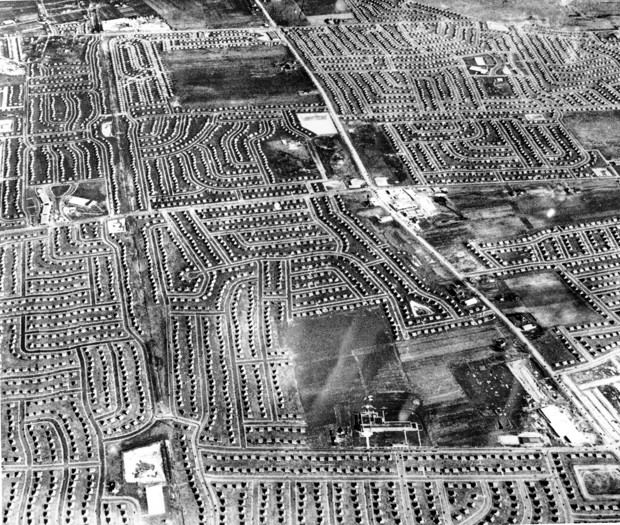Levittown - the archetypal suburb - was sold with covenants to sell only to Caucasians - a fact that my fellow Levittowner Bill O'Reilly says he learned only a few months ago. The house above is easy walking distance from the one where we lived until I finished sixth grade. 100% white. The first time I saw a Black person in my life was at Jones Beach. - gwc
How the Federal Government Built White Suburbia - CityLab
Federal housing policies didn’t just deny opportunities to black residents. They subsidized and safeguarded whites-only neighborhoods.
by Kristin Capps
Just two minutes into the first address at the 2015 National Fair Housing Conference on Tuesday, the conversation turned to Show Me a Hero. It was only a matter of time. Housing policy and Winona Ryder just don’t intersect that often.
But the conversation got real just as quickly. Richard Rothstein, a research associate at the Economic Policy Institute, gave a barn-burner of an address at the conference, a program convened by the U.S. Department of Housing and Urban Development.
“We’ve all forgotten how federal, state, and local governments consciously segregated our metropolitan areas by race,” Rothstein said.
His speech is a potent reminder. Rothstein delivered his address on modern residential segregation last year at The Atlantic’s “Reinventing the War on Poverty” conference. It’s worth your time to read the full talk. The rough outline below covers many of the policy levers that leaders at all level of government used to build and safeguard white residential areas.

The Federal Government Built Exclusively White Neighborhoods
- Federally funded public housing got its start in the New Deal. From the very beginning, public housing was segregated by race. Harold L. Ickes, the U.S. Secretary of the Interior and the most liberal member of President Franklin D. Roosevelt’s brain trust, proposed the “neighborhood composition rule,” which said that segregated public housing would preserve the segregated character of neighborhoods. (This was the liberalposition. Conservatives preferred to build no public housing for black people at all.)
- After World War II, the Federal Housing Administration (a precursor to HUD) and the Veterans Administration hired builders to mass-produce American suburbs—from Levittown near New York to Daly City in the Bay Area—in order to ease the post-war housing shortage. Builders received federal loans on the explicit condition that homes would not be sold to black homebuyers.
- The Housing Act of 1949, a tentpole of President Harry Truman’s Fair Deal, greatly expanded the reach of the public housing program, which was then producing the most popular form of housing (!) in the country. In an effort to kill the bill, conservatives tried to tack on a “poison pill” to the legislation: an amendment that would have required public housing to be integrated.
Government Policy Guided Segregation at the Neighborhood Level
- Way back in 1917, after the U.S. Supreme Court struck down certain segregation rules, Baltimore launched an official Committee on Segregation as a workaround. The committee organized neighborhood associations in order to promote restrictive covenants and otherwise intimidate white homeowners or real-estate agents who were selling to black buyers.
- In St. Louis, segregated housing developments replaced neighborhoods that were roughly 55 percent white and 45 percent black.
- San Francisco wanted to build integrated public housing near the Hunters Point Shipyard development, but the Navy wouldn’t allow it.
- In 1984, The Dallas Morning News surveyed federally funded housing projects in 47 metro areas. All of them and their 10 million residents weresegregated by race. The white projects that remained by the 1980s had better facilities, amenities, and maintenance than the others.
Ghettoes Are the Mirror of White Suburbs
- Pruitt–Igoe, the notorious and short-lived public housing project in St. Louis, was designed to be segregated. Pruitt was for blacks, Igoe was for whites. But by the time the development was completed in 1955, the housing shortage had grown less pressing for whites (thanks to efforts to repopulate them in the suburbs). The waiting list for Pruitt was long; Igoe experienced vacancies. Before Pruitt–Igoe met its early demise, its towers were entirely opened to black residents, like most formerly whites-only housing projects.
Courts Often Endorse a Myth of ‘De Facto’ Segregation
- In 1974, Supreme Court Justice Potter Stewart argued in Milliken v. Bradley—a case about busing—that segregation in Detroit schools was caused by “unknown and unknowable factors.”
- As recently as 2007, Supreme Court Justice Stephen Breyer and Chief Justice John Roberts ruled (in Parents Involved in Community Schools v. Seattle School District No. 1 ) that racially segregated neighborhoods were the result of de facto isolation, not de jure segregation. (Meaning that residential segregation was a matter of choice among residents, not consequence decided by law.)
A Federal Project Like Levittown Cannot Be Undone Locally
- In 1947, white buyers could purchase homes in Levittown for $8,000 (which is roughly $84,000 in 2015 dollars). Today, the median housing value in Levittown is $365,000, per Census data. The Long Island suburb built more than 17,000 Levitt homes, nearly all of which were leased or purchased by whites, thanks to racial covenants guided originally by the terms of the Federal Housing Administration loans.
- While African Americans are allowed to live in Levittown now, they by and large do not: The city’s population is 89 percent white and less than 1 percent black. New York City, meanwhile, is 26 percent black and just 44 percent white.
There’s more to Rothstein’s talk than a laundry-list of dates and figures, so read his essays about the root causes of contemporary segregation. Start hereor here or here or here. His challenge is consistent throughout.
“Government thinks things done by accident can only be remedied by accident,” he said. “Things done on purpose can only be remedied on purpose.

No comments:
Post a Comment